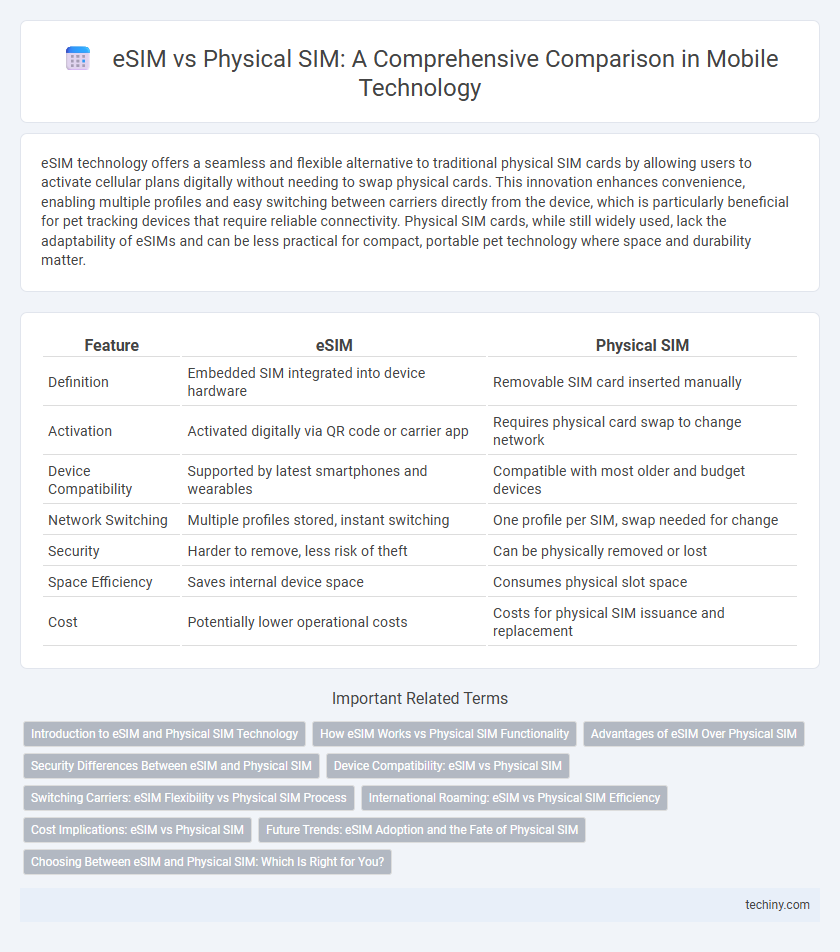eSIM technology offers a seamless and flexible alternative to traditional physical SIM cards by allowing users to activate cellular plans digitally without needing to swap physical cards. This innovation enhances convenience, enabling multiple profiles and easy switching between carriers directly from the device, which is particularly beneficial for pet tracking devices that require reliable connectivity. Physical SIM cards, while still widely used, lack the adaptability of eSIMs and can be less practical for compact, portable pet technology where space and durability matter.
Table of Comparison
| Feature | eSIM | Physical SIM |
|---|---|---|
| Definition | Embedded SIM integrated into device hardware | Removable SIM card inserted manually |
| Activation | Activated digitally via QR code or carrier app | Requires physical card swap to change network |
| Device Compatibility | Supported by latest smartphones and wearables | Compatible with most older and budget devices |
| Network Switching | Multiple profiles stored, instant switching | One profile per SIM, swap needed for change |
| Security | Harder to remove, less risk of theft | Can be physically removed or lost |
| Space Efficiency | Saves internal device space | Consumes physical slot space |
| Cost | Potentially lower operational costs | Costs for physical SIM issuance and replacement |
Introduction to eSIM and Physical SIM Technology
eSIM technology enables devices to download mobile network profiles digitally, eliminating the need for physical SIM cards and providing seamless carrier switching. Physical SIM cards are plastic chips inserted into devices to store subscriber information and authenticate network access. eSIMs offer enhanced flexibility and space-saving advantages compared to traditional physical SIMs, which require manual swapping for network changes.
How eSIM Works vs Physical SIM Functionality
eSIM operates by embedding a programmable chip directly within the device, allowing remote provisioning and seamless switching between carriers without the need to insert or replace a physical card. In contrast, a physical SIM consists of a removable plastic card containing a unique identifier that must be manually inserted into the device to authenticate the user on the network. eSIM technology enhances flexibility and convenience by enabling multiple profiles on one device, while physical SIM cards offer straightforward, hardware-based authentication requiring physical handling for activation or changes.
Advantages of eSIM Over Physical SIM
eSIM technology offers greater flexibility by allowing users to switch carriers and plans without swapping physical cards, enabling seamless multi-network connectivity for travelers and frequent switchers. Enhanced security features of eSIM minimize risks associated with SIM card theft or cloning, as activation and management are encrypted and remotely controlled. Its compact design eliminates the need for a SIM slot, allowing manufacturers to build slimmer, more durable devices with improved water and dust resistance.
Security Differences Between eSIM and Physical SIM
eSIM technology offers enhanced security by securely storing multiple profiles in an embedded chip, reducing the risk of physical tampering or SIM card swapping attacks common with physical SIMs. eSIM supports remote provisioning and instant activation, which minimizes exposure to theft or cloning compared to removing and replacing physical SIM cards. The encrypted communication and authentication protocols in eSIM frameworks bolster protection against SIM-related fraud and unauthorized access.
Device Compatibility: eSIM vs Physical SIM
eSIM technology offers enhanced device compatibility by supporting multiple profiles on a single embedded chip, enabling seamless switching between carriers without the need for physical card swaps. Physical SIM cards require specific slots, limiting usage to devices with compatible hardware, whereas eSIM integration is increasingly adopted in the latest smartphones, tablets, and wearables. This shift towards eSIM provides broader connectivity options and future-proofs devices against traditional SIM card constraints.
Switching Carriers: eSIM Flexibility vs Physical SIM Process
eSIM technology enables instant carrier switching without the need to physically replace SIM cards, offering unmatched flexibility for users who frequently change networks or travel internationally. Physical SIM cards require manual removal and insertion, which can be time-consuming and increases the risk of card damage. This dynamic of eSIM versus physical SIM highlights the growing preference for seamless, software-based mobile connectivity solutions in modern telecommunication.
International Roaming: eSIM vs Physical SIM Efficiency
eSIM technology enhances international roaming efficiency by enabling instant carrier switching without the need to physically replace SIM cards, reducing downtime and hassle for travelers. Physical SIM cards often require visitors to purchase local SIMs or endure high roaming fees, whereas eSIM supports multiple profiles and remote provisioning, streamlining connectivity management across borders. This flexibility makes eSIM a superior solution for seamless, cost-effective global mobile access.
Cost Implications: eSIM vs Physical SIM
eSIM technology reduces costs by eliminating the need for plastic cards and physical distribution, lowering manufacturing and logistical expenses compared to traditional physical SIMs. Mobile carriers benefit from streamlined activation processes, reducing operational costs associated with SIM replacement and shipping. However, initial infrastructure investments for eSIM compatibility may offset savings, but long-term cost efficiency favors eSIM adoption over physical SIM cards.
Future Trends: eSIM Adoption and the Fate of Physical SIM
eSIM technology is rapidly gaining traction due to its convenience, enhanced security, and remote provisioning capabilities, which enable seamless switching between carriers without needing a physical card. Industry experts predict that by 2028, over 60% of new mobile devices will incorporate eSIMs, significantly reducing reliance on physical SIM cards. Despite this shift, physical SIMs are expected to remain in use for legacy devices and specific markets where infrastructure or user adoption lags behind.
Choosing Between eSIM and Physical SIM: Which Is Right for You?
Choosing between eSIM and physical SIM depends on your device compatibility, travel habits, and preference for convenience. eSIM offers seamless switching between carriers and multiple profiles without needing a physical card, ideal for frequent travelers and tech-savvy users. Physical SIM cards are widely supported, offering simplicity and ease of use for those who prefer tangible hardware or have older devices.
eSIM vs Physical SIM Infographic

 techiny.com
techiny.com